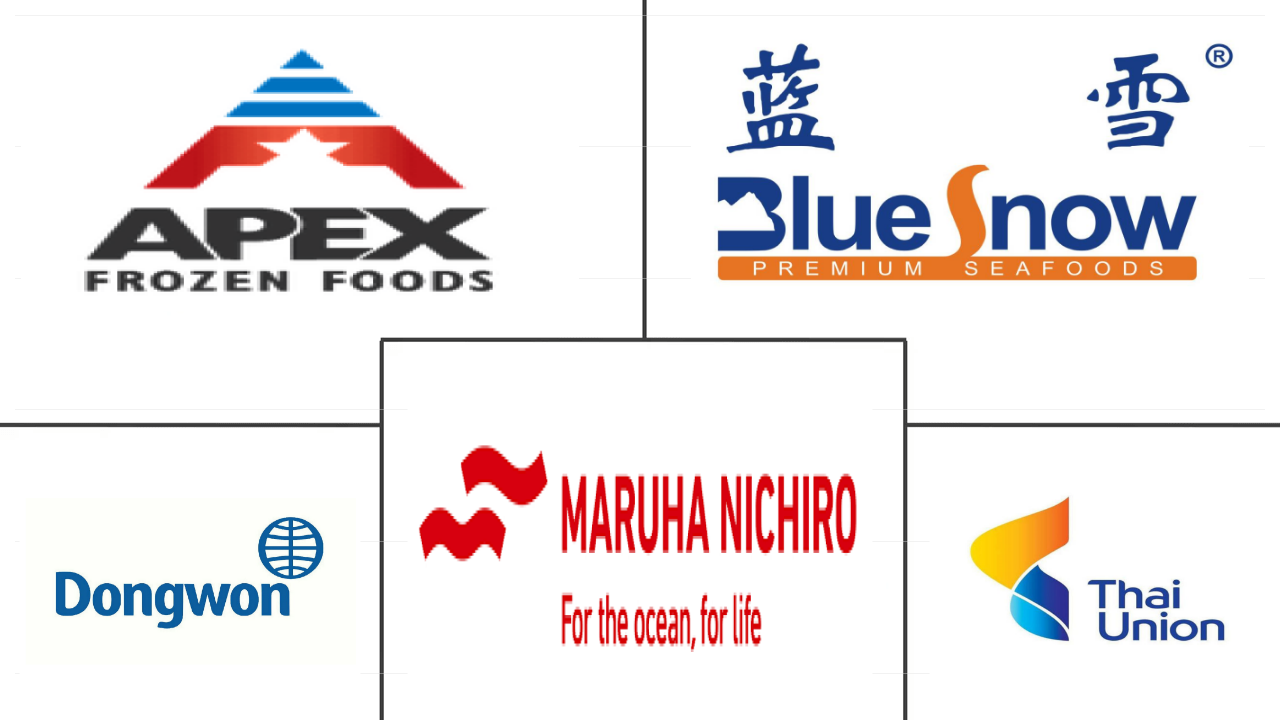Market Size of asia-pacific shrimp Industry
|
|
Study Period | 2017 - 2029 |
|
|
Market Size (2024) | USD 91.65 Billion |
|
|
Market Size (2029) | USD 96.98 Billion |
|
|
Largest Share by Distribution Channel | On-Trade |
|
|
CAGR (2024 - 2029) | 1.14 % |
|
|
Largest Share by Country | China |
Major Players |
||

|
||
|
*Disclaimer: Major Players sorted in no particular order |
Asia Pacific Shrimp Market Analysis
The Asia-Pacific Shrimp Market size is estimated at 91.65 billion USD in 2024, and is expected to reach 96.98 billion USD by 2029, growing at a CAGR of 1.14% during the forecast period (2024-2029).
91.65 Billion
Market Size in 2024 (USD)
96.98 Billion
Market Size in 2029 (USD)
2.00 %
CAGR (2017-2023)
1.14 %
CAGR (2024-2029)
Largest Segment by Country
61.23 %
value share, China, 2023
China was one of the most significant importers of shrimp in the region, with traders and distributors trying to cater to the increasing demand for fresh and frozen shrimp.
Largest Segment by Form
58.93 %
value share, Frozen, 2023
Frozen shrimp is mainly purchased in bulk by the foodservice industry, with the growth being driven by the rising demand for Argentine red shrimp and Pacific wild shrimp.
Fastest-growing Segment by Country
2.46 %
Projected CAGR, Australia, 2024-2029
Shrimp sales in Australia are driven by the development of processed and innovative value-added shrimp products, which is anticipated to continue in the forecast period as well.
Fastest-growing Segment by Form
1.84 %
Projected CAGR, Processed, 2024-2029
With technological advancements and innovations in the seafood sector, shrimp processing has become more refined, and the shelf life of shrimp products has improved.
Leading Market Player
0.51 %
market share, Apex Frozen Foods Ltd, 2022

The company offers a wide range of shrimp products in the Asia-Pacific region and has developed a vast distribution network allowing them to reach to broader consumer base.
Demand from the foodservice industry and a rise in e-commerce are driving the sales of shrimp
- The on-trade channel dominates the processed shrimp market; by value, it registered a growth of 4.59% through the on-trade channel between 2019 and 2022. The foodservice industry primarily acquires processed shrimp due to its high quality. Shrimps may be infected with diseases that have negative health effects on people. Disease transmission is avoided by processing and packaging with safety precautions. However, prices are extremely dependent on shrimp farmers, as the aquaculture sector in the region has been expanding rapidly. Most farmed animals have a mortality rate of around 1% per month.
- The off-trade channel is the fastest-growing channel in the shrimp market, and it is projected to witness a CAGR of 1.17% during the forecast period. Key players such as Thai Union Group PCL, Wynntech Star Sdn Bhd, Apex Frozen Foods Ltd, and Blue Snow Food Co. Ltd focus on product innovation and expansion through various retail channels such as supermarkets and online stores. The changing food habits and spending patterns and busy lifestyles of the growing working population are increasing the demand for processed shrimp to meet dietary habits.
- E-commerce grew rapidly during the historical period (2017-2022). The pandemic boosted the growth of online sales of shrimp in the region. Increased mobile accessibility and broadband penetration are disrupting the traditional grocery-buying business model. Online channels are enabling consumers to purchase groceries anywhere, at any time. In 2022, the penetration rate of online grocery shopping in China reached 10.28%. Online channels are further anticipated to grow in the country during the forecast period.
Production and imports in the region are expanding owing to an increase in domestic demand for seafood
- China is the market leader in shrimp production, followed by Indonesia and India. China has one-fifth of the world's population and accounts for one-third of the world's seafood production, including shrimp. China is deemed to be the largest aquaculture shrimp producer globally, with the production of shrimp rising from 1.9 million metric ton to 2 million metric ton over 2020-2022. Consumer demand for shrimp has been strong in the retail and catering trade in the Chinese market, while supply gaps are increasingly met through imports. In 2022, imports increased by 25.8% at 370,123 ton with Ecuadorean shrimp, the top product group, having lion's share (60%), followed by India (12.5%), Vietnam (6%), Canada (3.6%), and Greenland (3%).
- Indonesia is the second largest shrimp consumer in the Asia-Pacific, with sales value registering a CAGR of 1.20% over 2017-2022. The domestic demand for shrimp is relatively lower than other seafood varieties as shrimp is still considered a costly source of protein for most households, owing to which 95% of the production is exported by the country. However, the rising income of the consumers is boosting shrimp consumption, with the on-trade segment dominating the market with a share of 58.61% in 2022.
- Australia is expected to register the fastest growth during the forecast period, with the current sales value expanding by 7.16% over 2019-2022. Due to the higher farming costs of Australian shrimp, they are often more expensive. Nonetheless, aquaculture is expanding domestically and developed with environmental and sanitation restrictions set by government agencies, which may scale further to expand the market for shrimp in the country, which is currently in a nascent state.
Asia-Pacific Shrimp Industry Segmentation Asia Pacific Shrimp Industry Segmentation
Canned, Fresh / Chilled, Frozen, Processed are covered as segments by Form. Off-Trade, On-Trade are covered as segments by Distribution Channel. Australia, China, India, Indonesia, Japan, Malaysia, South Korea are covered as segments by Country.
- The on-trade channel dominates the processed shrimp market; by value, it registered a growth of 4.59% through the on-trade channel between 2019 and 2022. The foodservice industry primarily acquires processed shrimp due to its high quality. Shrimps may be infected with diseases that have negative health effects on people. Disease transmission is avoided by processing and packaging with safety precautions. However, prices are extremely dependent on shrimp farmers, as the aquaculture sector in the region has been expanding rapidly. Most farmed animals have a mortality rate of around 1% per month.
- The off-trade channel is the fastest-growing channel in the shrimp market, and it is projected to witness a CAGR of 1.17% during the forecast period. Key players such as Thai Union Group PCL, Wynntech Star Sdn Bhd, Apex Frozen Foods Ltd, and Blue Snow Food Co. Ltd focus on product innovation and expansion through various retail channels such as supermarkets and online stores. The changing food habits and spending patterns and busy lifestyles of the growing working population are increasing the demand for processed shrimp to meet dietary habits.
- E-commerce grew rapidly during the historical period (2017-2022). The pandemic boosted the growth of online sales of shrimp in the region. Increased mobile accessibility and broadband penetration are disrupting the traditional grocery-buying business model. Online channels are enabling consumers to purchase groceries anywhere, at any time. In 2022, the penetration rate of online grocery shopping in China reached 10.28%. Online channels are further anticipated to grow in the country during the forecast period.
| Form | |
| Canned | |
| Fresh / Chilled | |
| Frozen | |
| Processed |
| Distribution Channel | ||||||
| ||||||
| On-Trade |
| Country | |
| Australia | |
| China | |
| India | |
| Indonesia | |
| Japan | |
| Malaysia | |
| South Korea | |
| Rest of Asia-Pacific |
Asia-Pacific Shrimp Market Size Summary
The Asia-Pacific shrimp market is experiencing a steady growth trajectory, driven by expanding aquaculture and evolving consumer preferences. The on-trade channel, particularly within the foodservice industry, remains a dominant force due to the high quality of processed shrimp. This segment benefits from rigorous safety measures that mitigate health risks associated with shrimp diseases. The off-trade channel is emerging as the fastest-growing segment, fueled by changing dietary habits and the convenience of online shopping. Key industry players are leveraging product innovation and strategic expansions across various retail platforms to capture the growing demand. The region's shrimp production is led by China, followed by Indonesia and India, with China being the largest global producer. The market dynamics are influenced by factors such as rising production costs, disease challenges, and the impact of global economic conditions on shrimp prices.
The market landscape is characterized by a fragmented structure, with major companies like Apex Frozen Foods Ltd, Blue Snow Food Co. Ltd, and Thai Union Group PCL playing significant roles. The Asia-Pacific region accounts for a substantial portion of global shrimp production, with Indonesia and China being key contributors. Despite challenges such as disease outbreaks and fluctuating feed costs, initiatives like India's Pradhan Mantri Matsya Sampada Yojana aim to boost production capabilities. The region's shrimp market is also witnessing a shift towards online sales channels, driven by increased mobile and internet accessibility. As the market evolves, the interplay of domestic demand, export opportunities, and regulatory frameworks will continue to shape the industry's growth prospects.
Asia-Pacific Shrimp Market Size - Table of Contents
-
1. MARKET SEGMENTATION (includes market size in Value in USD, Forecasts up to 2029 and analysis of growth prospects)
-
1.1 Form
-
1.1.1 Canned
-
1.1.2 Fresh / Chilled
-
1.1.3 Frozen
-
1.1.4 Processed
-
-
1.2 Distribution Channel
-
1.2.1 Off-Trade
-
1.2.1.1 Convenience Stores
-
1.2.1.2 Online Channel
-
1.2.1.3 Supermarkets and Hypermarkets
-
1.2.1.4 Others
-
-
1.2.2 On-Trade
-
-
1.3 Country
-
1.3.1 Australia
-
1.3.2 China
-
1.3.3 India
-
1.3.4 Indonesia
-
1.3.5 Japan
-
1.3.6 Malaysia
-
1.3.7 South Korea
-
1.3.8 Rest of Asia-Pacific
-
-
Asia-Pacific Shrimp Market Size FAQs
How big is the Asia-Pacific Shrimp Market?
The Asia-Pacific Shrimp Market size is expected to reach USD 91.65 billion in 2024 and grow at a CAGR of 1.14% to reach USD 96.98 billion by 2029.
What is the current Asia-Pacific Shrimp Market size?
In 2024, the Asia-Pacific Shrimp Market size is expected to reach USD 91.65 billion.

